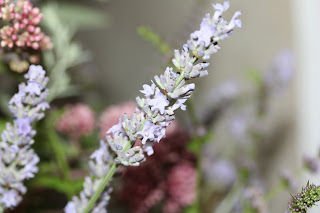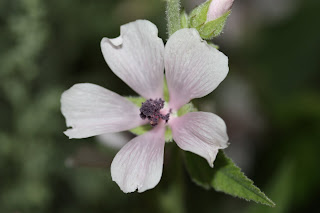Anatomy of a Flower Arrangement
How often does a garden plan go awry only to find that you have something equally as good, if not better, instead? This is what happened to one of my designs, a large area taking up almost one quarter of a walled kitchen garden.
.
 .
.
Formal beds, surrounded by box(wood) hedging and topiary, were planted to create what was to be a tisane, or herbal tea, garden. All the plants were supposed to be suitable for making infusions for either medicinal or culinary use. Something went wrong and, for reasons unknown, half the plants either died or refused to flourish. In desperation, we turned it into a cutting garden where flowers could be harvested for arrangements for the big house - actually, the mystery house I used to dream of as a child. I have written about this house before and the tale of my arriving there two hundred years after I had died....
.
 .
.Formal beds, surrounded by box(wood) hedging and topiary, were planted to create what was to be a tisane, or herbal tea, garden. All the plants were supposed to be suitable for making infusions for either medicinal or culinary use. Something went wrong and, for reasons unknown, half the plants either died or refused to flourish. In desperation, we turned it into a cutting garden where flowers could be harvested for arrangements for the big house - actually, the mystery house I used to dream of as a child. I have written about this house before and the tale of my arriving there two hundred years after I had died....
Concentrating on those plants that survived the initial planting, I decided to see how they would cope with being used as cut flowers and the result was much better than expected. The flowers were cut in the middle of the hottest day of this year so far - not ideal conditions - and then plunged up to their necks in water for the rest of the afternoon. They looked poorly and drooping when first arranged but perked up overnight and now, ten days later, look as fresh as ever.
.
Much of the structure is created with a framework of Artemisia 'Powis Castle'. I find that to get the best results it is necessary to prune this shrub down to ground level each spring. They then produce long wands of stunning silvery foliage. A bitter herb used for all sorts of ailments, I would have to feel very ill before I would consider drinking a tea made from this!
.
At this point, I should stress, that I am no herbalist so I do not recommend that you try out any of these plants without deciding for yourself whether they will do you good or kill you instead.
.
Hemp Agrimony, Eupatorium cannabinum, is a British native plant, normally found growing in damp places but quite happy in the garden border. The Joe Pye of America, it is claimed that it is good for many different ailments but especially good for gout.
.
A big surprise, was this Spearmint. In the cutting garden it has grown exceptionally tall (and like all mints, proving rather invasive) with attractive, fine flowers. This is, of course, one that I can safely recommend for use as a culinary herbal tea, very refreshing on a hot summers day and good if you suffer with indigestion.
.
Lavender needs no introduction. Oddly enough, because of soil conditions, I thought they would struggle in this garden. Instead, they have thrived.
.
Marjoram, another common herb that grows wild in England on sunny banks, also needs no description from me. It is our best bee and butterfly plant in the garden, even outrivalling Buddleias. We grow it in huge patches throughout the garden.
.
 .
.
Beautiful, downy, soft-as-velvet leaves and the merest hint of pink flowers, they require no staking, suffer from no pests or diseases and grow year after year, getting ever stronger. And, of course, you can always make marshmallow sweets to eat from their dried, powdered roots.
.
Leaving the best to last and the biggest surprise of the lot! Marsh-mallow, Althaea officinalis, another UK native. This was the first time I had grown it and it is now one of my 'signature' plants that I try to incorporate into every design. Related to Hollyhocks but only about half their height and very much more delicate in every way, except one - they are as tough as old boots!
.
 .
.Beautiful, downy, soft-as-velvet leaves and the merest hint of pink flowers, they require no staking, suffer from no pests or diseases and grow year after year, getting ever stronger. And, of course, you can always make marshmallow sweets to eat from their dried, powdered roots.
.









Dear Johnson, Ah, yes, the best laid plans and all that. The 'cutting garden' as it is now looks to be thriving. For me, it is all held together by those wonderful lines of Buxus and the topiary finials.
ReplyDeleteStrangely, my own recent posting is about cut flowers. Great minds....
Absolutely beautiful! And what a pleasure to see an unpredictable arrangement of cut flowers!
ReplyDeleteDear Johnson, I discovered your blog via Edith Hope - it's really interesting! I tried to look up "marsh mallow", but couldn't find them even under "Index of common names". They look so fine and I'm always interested in uncomplicated beauties (with Ladies this might be an oxymoron).
ReplyDeleteThanks, as always, for taking the time to comment.
ReplyDeleteAnd, welcome, Britta, to my blog and thank you for becoming a follower. I think the German name for the plant marshmallow is Eibisch.
Johnson
Congratulations on your first year's blogging Johnson - it's amazing just how fast the time passes isn't it? I've had a cutting garden this year for the first time and found I've really enjoyed it and not been so worried about ruining my borders by cutting flowers for indoors. Marsh mallow is a regular self seeder here too, not surprisingly as we are on Cotswold border not far from you.
ReplyDeleteThanks Kathy. Cutting gardens are good fun - perhaps because you don't have to feel guilty about picking the flowers.
ReplyDeleteMy wild flower book says that marsh mallow grows in the south along the coast in damp places. Since it grows so readily in the garden you would have thought that,in the wild, it would have spread inland.
I've noticed that there are lots of other wild mallows in full bloom along the road edges now. Will have to try and get some photos.
Johnson
Absolutely wonderful garden its hows that the florals there is really beautiful. Keep posting guys!
ReplyDeleteflower Philippine
Thanks Ford for taking time to comment. I'm glad that you enjoyed the post.
ReplyDeleteJohnson